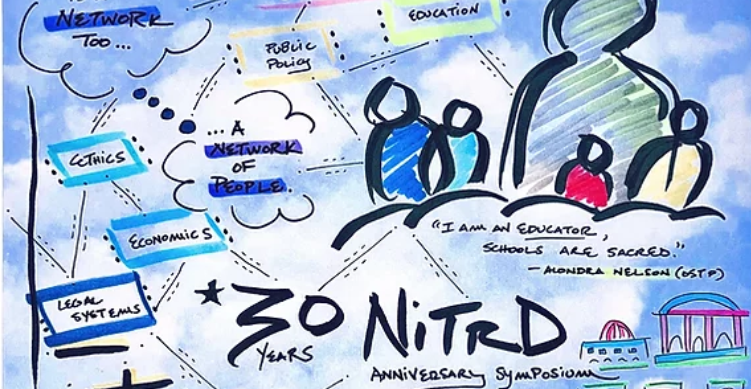(This article appeared as a CCC BLOG post on June 14, 2022.)
Last month the Networking and Information Technology Research and Development (NITRD) program commemorated their 30th Anniversary in Washington D.C. You can read the full event recap here. In an effort to highlight the impact federal investments have had on the computing research community, the event featured five panels in which participants discussed key achievements in the field over the past decade and future directions going forward. Each panel focused on an important subarea of computer research: Computing at Scale, Networking and Security, Artificial Intelligence/Machine Learning, Privacy and the Internet of Things and Socially Responsible Computing.
This post is the first in a series highlighting the panels from that day, starting with Panel 1: Computing at Scale, moderated by Ben Zorn (Microsoft) and featuring distinguished panelists Luiz André Barroso (Google), Ian Foster (Argonne NL), Timothy Pinkston (USC), and Kathy Yelick (UCB). The panel led a riveting discussion celebrating the incredible past achievements of high performance computing (HPC) and cloud computing, as well as looking ahead to where this technology is going and how it is affecting society.
Zorn kicked off the session with an anecdote from his career to highlight the enormous increase in availability of computing cycles for various purposes, which was made possible by advances in computational scalability. He gave the example of starting off as a researcher at Microsoft in 1992 when creating programs by simply expressing what you want, instead of writing code, was just a vision. Now 10 years later, we have a new technology on the horizon that takes program descriptions and creates a solution to that description entirely autonomously.
The first question raised to panelists was “In what ways have NITRD investments accelerated advances in computing at scale and what made those investments successful?”
Foster reflected on the beginning of his career, reminiscing about the six processor computers he worked with compared to today’s that are roughly a billion times faster incorporating what he estimates to be a million more processors. He went on to say, “bigger and faster is great but what has it enabled”? Panelists brought up a multitude of achievements including the deep learning revolution, remarkably accurate weather forecasts that can look out ten days in advance, new drug designs, Google Brain, multicore and distributed systems with the power to rival the supercomputers of the day. The panelists all agreed that every single one of these accomplishments can be linked back to research in labs and university settings with support from programs coordinated by NITRD.
The second question Zorn proffered to the panel was, What are important societal outcomes that NITRD investments in computing at scale have enabled and where are the opportunities for even greater impact?
Yelick shared that some of the big breakthroughs fueled by HPC have been in the simulation area – with the ability to simulate and make predictions both for long-term climate change and short-term weather fluctuations, advancements in material science, including screening new materials for various energy applications and drug discovery, sequencing massive datasets and deep learning based artificial intelligence.
Looking beyond innovations for societal impact, Barroso continued off Foster’s comment about NITRD’s important contributions creating computing and data facilities and enabling and sustaining interdisciplinary teams.
“The ability we have these days to bridge this gap and give tools to these professionals to have extremely irreplaceable domain knowledge and allow them to apply really high end computing technologies to what they do with less and less friction over time, it’s incredibly inspiring to me.” – Luiz André Barroso
The third question Zorn posed to the group was, “Given how hardware applications, cloud infrastructure and computing at scale, including cost in tradeoffs, have rapidly changed in the last five years – should NITRD investments in computing at scale change and if so how?”
With the ending of Moore’s Law (a doubling of computing capability) Pinkston applauded NITRD’s past contributions to the remarkable acceleration and expansion of computing and urged new investments to view Moore’s law more broadly in terms of setting goals and expectations. In this broader context we can view the notion of exponential improvement among various dimensions including, not only overall functionality, capability and performance but also reduced costs, reduced form factor, growth and robustness of applications, increased security, reliability, and trustworthiness, and increased energy efficiency and sustainability at scale. Now is the time to make new and important investments in potentially high risk, but high payoff technologies. Yelick expanded on Pinkston’s comment, suggesting NITRD invest in a broader spectrum of things such as different kinds of processors and accelerators.
Zorn wrapped up the panel with the final question, “Looking forward, how should NITRD investments in computing at scale take into account the increasing need to understand and implement a socially responsible application of computing technology?
The panelists hit on two important aspects of this question: accessibility and ethics. Two key thoughts touched on both:
“There are the breakthroughs that make the impossible possible, which are inspiring, and then there are the others that make the possible available.” – Luiz André Barroso
People tend to only get excited about huge developments and breakthroughs, resulting in less attention and investments into making these achievements and innovations accessible to more people.
Pinkston turned our attention to the question of ethics in computing, as he quoted previous CCC Chair Mark Hill, saying, “It’s not really the question about what we can build, but what should we build?”
Future investments need to consider the who, why, where, and what taking into account ethics, accessibility, and the impact of the technologies being built.
An audience member asked what principles NITRD, academia, govt labs etc. should use so that their investments compliment or at least don’t duplicate what industry is doing?
The panelists all answered in the same vein – invest in crazier ideas, ideas with an amazing reward but remarkable risks, ideas that have no commercial payoff. Companies care about their bottom line and tend to be more conservative with their return on investment. Investing in areas outside of fundamental science will lead to advances in human understanding and discovery and lay a foundation of coordination between industry, government and academic research.
Panel 1 was a fantastic way to begin the day, and it ignited conversations and ideas that were threaded into other panels as the day went on. Thank you to all the session participants for sharing your ideas and opinions. I think it is clear that there has been tremendous progress in computing at scale thanks to NITRD investments and many achievements to come. You can watch the full recording on the CCC web page or on NITRD’s YouTube channel. Be on the lookout for Panel 2: Networking and Security.
###


